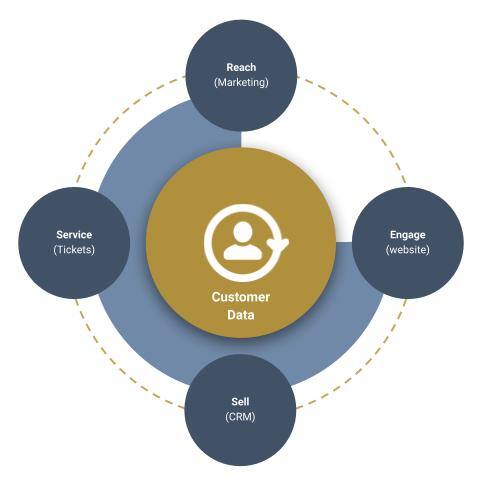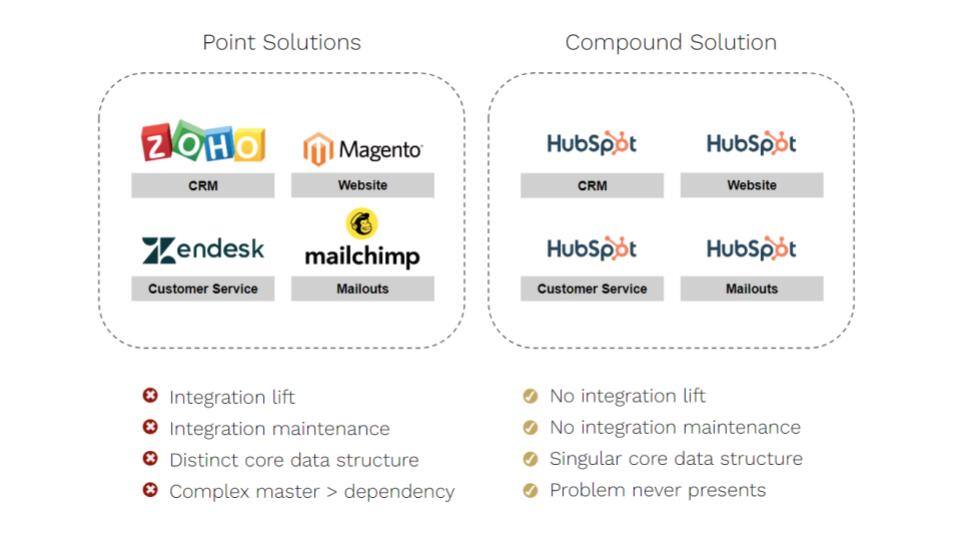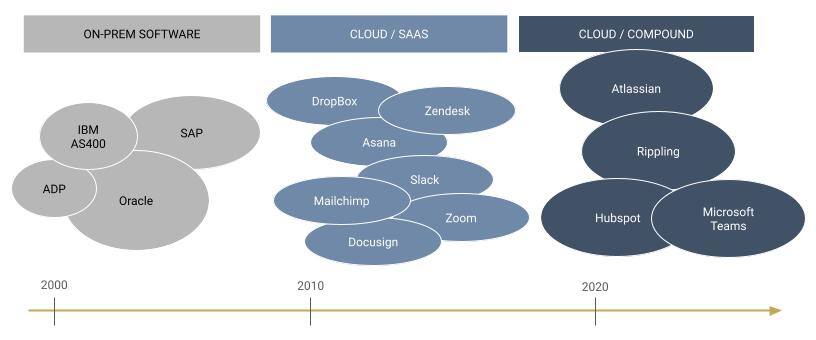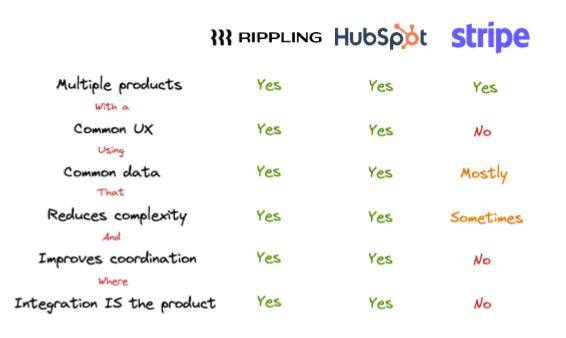The CTO's guide for Unlocking the Backlog
Understanding how a compound strategy can save you money on license fees, improve staff efficiency & unlock your IT roadmap
Executive Summary
In today’s fast-paced retail environment, technology executives face an increasingly complex web of systems and data sources that must be managed effectively to maintain competitive advantage. A compound strategy - focusing on a unified technology architecture matching single applications to identified core data sets - offers significant advantages over relying on multiple point solutions. The inefficiencies caused by integrating disparate systems and ensuring data consistency can often lead to higher costs, slower operations, and reduced agility.
This paper explores how a compound approach can streamline operations, reduce complexity, and improve data accuracy. We will contrast this approach with a point-solution strategy that requires significant integration efforts and complex logic to synchronize changing data across various systems.
Identifying Core Data Sets is Critical
In every business, there are certain data sets that multiple business functions rely upon to do their jobs. In jewelry retail, some examples are customer data, transactional data, and product data. Often times, these data sets are managed in siloes by various business units, resulting in data discrepancies as data is shared (or not shared) cross-functionally. In order to unlock organizational efficiency, IT executives can identify core data sets and optimize their tech stacks to ensure core data sets can flow through the architecture in a streamlined manner.

Point vs Compound Solutions
Retail companies rely on a vast array of technology systems to manage various business functions. From inventory management and customer relationship management (CRM) to Product Information Management (PIM) and Product Life Cycle Management (PLM), to sales analytics and supply chain logistics, the choice between deploying point solutions or a unified system architecture is a critical decision.
A point solution is software designed to address a specific aspect of the business. It typically excels in its niche but does not always integrate smoothly with other systems. This necessitates ongoing synchronization between systems and creates inevitable data inconsistencies when other point solutions depend on a shared core data set.
Conversely, compound software leverages a centralized data architecture where a single application is used to manage the core data set. By having one version of the truth, retail executives can drastically reduce the complexity and cost of maintaining their technology stack, whilst simultaneously ensuring the accuracy of data relied on by diverse groups of stakeholders across the business.

The Inefficiencies of Point Solutions in Jewelry Retail
In a vacuum, point solutions are an appealing solution to isolated problems that present themselves. However, technology executives are tasked with managing complex ecosystems, and do not have the luxury of solving problems in a vacuum. Point solutions often present significant drawbacks when viewed from a perspective of overall system efficiency:
1. Integration Overhead
- Point solutions, especially when deployed in silos, require integration to work together effectively. This often means building custom middleware to bridge the gap between systems, a task that can be costly and resource-intensive.
- For example, a Point of Sale system might need to constantly update the CRM with new customer data & transactions, while inventory management systems must be integrated with e-commerce platforms to reflect product availability in real-time. The more systems there are, the more complex the integration landscape becomes.
2. Data Consistency Challenges
- With multiple systems accessing the same data, maintaining consistency across application becomes a significant challenge. If a customer’s address is updated in one system but not in another, it can lead to issues such as shipping delays or errors in personalized marketing campaigns.
- This challenge often requires custom business logic and real-time data syncing across systems to ensure that updates in one application are accurately reflected in all related applications. This adds a layer of complexity that consumes IT resources and introduces potential points of failure.
3. Increased Operational Costs
- The costs associated with maintaining multiple point solutions go beyond licensing: integration development, system maintenance, and the continuous need to update and patch disparate systems add to the total cost of ownership.
- Additionally, businesses often need specialized IT staff or external consultants familiar with each point solution, increasing labor costs and limiting flexibility.
The Advantages of a Compound Strategy
Once you have identified your businesses' core data sets, a compound strategy offers a streamlined alternative that addresses the inefficiencies of point solutions:
1. A Single Source of Truth
- A centralized application ensures that all systems are drawing from and writing to the same data set. This eliminates the need for complex synchronization processes between multiple systems, resulting in higher data accuracy and consistency.
- For example, customer data (such as contact information, purchase history, and preferences) can reside in a single location, ensuring that all business functions—whether marketing, customer service, or sales—are using up-to-date and accurate information.
2. Reduced Complexity
- Integrating multiple point solutions can result in a tangled web of interdependencies that are difficult to maintain. A single data set reduces the need for constant integrations, making system architecture simpler and more scalable.
- This streamlined approach can enhance agility, allowing the organization to quickly respond to market changes without having to constantly manage complex integrations.
3. Lower Operational Costs
- By consolidating data into a single application, businesses can reduce costs related to infrastructure, development, and system maintenance. The reduced need for integration services and middleware leads to lower upfront and ongoing expenses.
- Furthermore, centralized systems often require less specialized personnel to maintain, enabling a more cost-effective and efficient IT operation.
4. Improved Data Governance & Security
- Managing data across multiple applications increases the risk of inconsistent security protocols and fragmented data governance policies. A single application allows for standardized data management practices and centralized security protocols, reducing the risk of data breaches and regulatory non-compliance.
- Centralized data storage also makes it easier to comply with regulations like GDPR, where organizations need to ensure that personal data is consistently protected and easily retrievable.
5. Enhanced Customer Experience
- In retail, a seamless customer experience is paramount. Whether it’s delivering consistent product recommendations across channels or ensuring timely updates on order status, having all customer data in a unified system enables more personalized and cohesive experiences.
- For example, with a single application, a customer’s preferences and purchase history are accessible across online and offline channels, ensuring that every interaction is contextually relevant and informed by the latest data.
The Evidence Is Clear: Compound Strategies Are Winning
CTOs can look back over the past three decades to validate the influence of compound products. Of course, compound software is not a recent invention - before the dawn of the internet every software was necessarily compound as we lacked any effective mechanism to have software A talk to software B.

After the internet recovered from its peak of inflated expectations - the dot com bubble of 1998 - venture capitalists first fueled the expansion of e-commerce and thereafter business productivity tools that would go on to form a new category of software: "SaaS" (Software as a Service). This "unbundling" of tools was made possible by the arrival of cloud servers and API technology that had the effect of levelling the playing field: the barriers to entry to building enterprise software had suddenly dropped and it was possible for small firms to specialize in a specific under-served niche and build billion dollar businesses in a relatively short period of time - Zendesk (service desk), Slack (business chat) and Docusign (contract execution) are all clear examples.
The problem that then presents itself over time is that the more point solutions you adopt, the more complex your integration landscape, and the more connecting lines on your technology stack diagram until it becomes unreadable.
This is typically the state we find retailers in when they approach Loupe: IT teams burdened with legacy on-prem core inventory systems that are too embedded to consider switching them out. On top of this, the IT teams are also carrying the maintenance burden of multiple point-solution SaaS products that are laser-focused on one specific task. But these multiple point-solutions don’t speak to each other, let alone with the legacy on-prem system, resulting in silo’d information and inevitably dissatisfied commercial stakeholders.
As this situation has proliferated, technology executives' appetite to add more point solutions to this burden has necessarily dropped. As a direct consequence compound solution providers have prospered as they have been able to pitch their solutions as consolidation mechanisms - consider:
- A Microsoft Teams sales associate "Why do you need to pay for this expensive Slack license when you have Teams for free and Teams is integrated out of the box to your Microsoft Drive and Inbox?"
- A Hubspot sales associate "You can save time and money by adding our Service Hub product onto your account. This will allow your sales and service teams to centralize their core data sets, removing both your Zendesk license and your internal integration overhead all the while improving customer experience"
The exception that proves the rule is Docusign: as a contract execution software the core value proposition is speed & ease of legal execution, and crucially there is no core data set that would make a compound solution more valuable than a point solution. In this case a technology executive pursuing a compound strategy would still buy and maintain Docusign.

Retail Case Study: Inventory Management
Consider a large retail company that operates both physical stores and an e-commerce platform. The inventory system is a critical function that connects online sales, warehouse stock, and in-store availability. With multiple point solutions, the company may need to sync inventory data across these systems in real-time. However, even minor delays in synchronization can lead to situations where an item appears in stock online but is sold out in-store, leading to dissatisfied customers.
By rooting all inventory-related data in a single application, the retail company can maintain real-time stock levels across all channels. When an item is sold in a physical store, the e-commerce platform is instantly updated, ensuring accuracy and avoiding stock-outs or overselling.
In cases of larger Enterprises, where the IT team is managing complex burden between legacy on-prem and go-forward cloud based point solutions, they will need to invest in dedicated data streaming technology to try and solve the problem:
https://www.confluent.io/blog/how-walmart-uses-kafka-for-real-time-omnichannel-replenishment/
Conclusion
For technology executives in retail, the decision to move away from point solutions in favor of a compound strategy that uses a single application for core data sets offers numerous benefits. By reducing complexity, improving data accuracy, and lowering operational costs, this approach can create a more agile and scalable technology infrastructure. In a retail environment where customer experience and operational efficiency are paramount, a single source of truth becomes a powerful tool to maintain competitiveness.
Ultimately, adopting a unified application architecture allows technology leaders to focus on innovation and growth, rather than managing the complexities of integrating and synchronizing disparate systems. As the retail landscape continues to evolve, a compound strategy provides the necessary foundation for long-term success.
Partner with people who see the same future as you
If the ideas in this article resonate with you and you would like us to review your technology stack & modernization strategy free of charge, we are always delighted to engage, share our insights, and learn from yours.

Dominic Hill
is Co-Chief Executive Officer at Loupe,
Based in Salt Lake City, Utah



